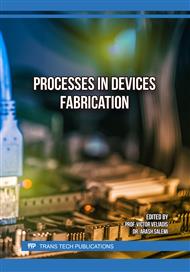[1]
S. Hino et al., "SiC-MOSFET Structure Enabling Fast Turn-On and -Off Switching," Materials science forum, vol. 717–720, p.1097–1100, (2012)
DOI: 10.4028/www.scientific.net/msf.717-720.1097
Google Scholar
[2]
T. Kimoto and J. A. Cooper, Fundamentals of Silicon Carbide Technology. Hoboken, NJ, USA: Wiley, (2014).
Google Scholar
[3]
R. Konishi, Ryuichi Yasukochi, O. Nakatsuka, Y. Koide, M. Moriyama, and M. Murakami, "Development of Ni/Al and Ni/Ti/Al ohmic contact materials for p-type 4H-SiC," Materials Science and Engineering: B, vol. 98, no. 3, p.286–293, (2003)
DOI: 10.1016/s0921-5107(03)00065-5
Google Scholar
[4]
M. Vivona, G. Greco, C. Bongiorno, R. Lo Nigro, S. Scalese, and F. Roccaforte, "Electrical and structural properties of surfaces and interfaces in Ti/Al/Ni Ohmic contacts to p-type implanted 4H-SiC," Applied Surface Science, vol. 420, p.331–335, (2017)
DOI: 10.1016/j.apsusc.2017.05.065
Google Scholar
[5]
R. Hou et al., "Ultra-Shallow Doping B, Mg, Ni, Cu, Mn, Cr and Fe into SiC with Very High Surface Concentrations Based on Plasma Stimulated Room-Temperature Diffusion," Journal of Materials Engineering and Performance, vol. 28, no. 1, p.162–168, (2018)
DOI: 10.1007/s11665-018-3782-z
Google Scholar
[6]
L. Ottaviani et al., "Plasma Immersion Ion Implantation Applied To N[sup +]P Junction Realisation In 4H-SiC," AIP conference proceedings, (2011)
DOI: 10.1063/1.3548362
Google Scholar
[7]
A. Hannan et al., "The Effect of Nitrogen Plasma Treatment Process on Ohmic Contact Formation to N-Type 4H-SiC," Diffusion and defect data, solid state data. Part B, Solid state phenomena/Solid state phenomena, vol. 359, p.59–63, (2024) Fig. 5
DOI: 10.4028/p-fpu9au
Google Scholar
[8]
Huseyin Ekinci, V. V. Kuryatkov, D. L. Mauch, J. C. Dickens, and S. A. Nikishin, "Plasma Etching of n-Type 4H-SiC for Photoconductive Semiconductor Switch Applications," Journal of Electronic Materials, vol. 44, no. 5, p.1300–1305, (2015)
DOI: 10.1007/s11664-015-3658-z
Google Scholar
[9]
S. Tsukimoto, K. Nitta, T. Sakai, M. Moriyama, and M. Murakami, "Correlation between the electrical properties and the interfacial microstructures of TiAl-based ohmic contacts to p-type 4H-SiC," Journal of Electronic Materials, vol. 33, no. 5, p.460–466, (2004)
DOI: 10.1007/s11664-004-0203-x
Google Scholar
[10]
F. Roccaforte et al., "Metal/Semiconductor Contacts to Silicon Carbide: Physics and Technology," Materials Science Forum, vol. 924, p.339–344, (2018)
DOI: 10.4028/www.scientific.net/msf.924.339
Google Scholar
[11]
H. Tamaso, S. Yamada, H. Kitabayashi, and T. Horii, "Ti/Al/Si Ohmic Contacts for both n-Type and p-Type 4H-SiC," Materials Science Forum, vol. 778–780, p.669–672, (2014)
DOI: 10.4028/www.scientific.net/msf.778-780.669
Google Scholar
[12]
B. H. Tsao, S. Liu, and J. D. Scofield, "Improved AlNi Ohmic Contacts to p-Type SiC," Materials Science Forum, vol. 457–460, p.841–844, (2004)
DOI: 10.4028/www.scientific.net/msf.457-460.841
Google Scholar


